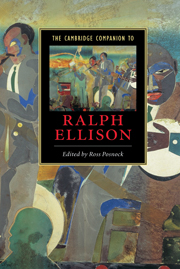Book contents
- Frontmatter
- Introduction
- 1 Ralph Ellison’s invented life
- 2 Ellison and the black Church
- 3 Ellison, photography, and the origins of invisibility
- 4 Ralph Ellison’s music lessons
- 5 Ralph Ellison’s constitutional faith
- 6 Ralph Ellison and the politics of melancholia
- 7 Invisible Ellison
- 8 Ellison’s experimental attitude and the technologies of illumination
- 9 Female iconography in Invisible Man
- 10 Chaos not quite controlled
- 11 Ralph Ellison, Hannah Arendt, and the meaning of politics
- 12 Dry bones
- Selected bibliography and suggestions for further reading
- Index
- Series List
4 - Ralph Ellison’s music lessons
Published online by Cambridge University Press: 28 May 2006
- Frontmatter
- Introduction
- 1 Ralph Ellison’s invented life
- 2 Ellison and the black Church
- 3 Ellison, photography, and the origins of invisibility
- 4 Ralph Ellison’s music lessons
- 5 Ralph Ellison’s constitutional faith
- 6 Ralph Ellison and the politics of melancholia
- 7 Invisible Ellison
- 8 Ellison’s experimental attitude and the technologies of illumination
- 9 Female iconography in Invisible Man
- 10 Chaos not quite controlled
- 11 Ralph Ellison, Hannah Arendt, and the meaning of politics
- 12 Dry bones
- Selected bibliography and suggestions for further reading
- Index
- Series List
Summary
Perhaps I like Louis Armstrong because he’s made poetry out of being invisible. I think it must be because he’s unaware that he is invisible. And my own grasp of invisibility aids me to understand his music . . . . Invisibility, let me explain, gives one a slightly different sense of time, you’re never quite on the beat. Sometimes you’re ahead and sometimes behind. Instead of the swift and imperceptible flowing of time, you are aware of its nodes, those points where time stands still or from which it leaps ahead. And you slip into the breaks and look around. That’s what you hear vaguely in Louis’s music.
Ralph Ellison, Invisible ManWithin the first pages of the 1952 novel Invisible Man Ralph Ellison's narrator relates Louis Armstrong's music to his own desires and self-conceptions. ''I'd like,'' the narrator writes, ''to hear five recordings of Louis Armstrong playing and singing 'What Did I Do To Be So Black and Blue' – all at the same time''. When Armstrong recorded the show tune by Andy Razaf and Fats Waller from the Broadway revue Hot Chocolates in 1929 he edited the lyrics to shift a dark-skinned female lover's lament over intra-racial color discrimination (the song's place within the plot of the musical Chocolate Dandies) toward a more general lament about racism. Ellison's narrator considers the lyrics but focuses more intently on the specifics of Armstrong's tone and phrasing. Ellison's seemingly central metaphor of invisibility takes on an aural dimension when he attends to Armstrong's ''lyrical beam'' and rhythmic mastery at creating a ''slightly different sense of time.'' The literary translation and transposition of Armstrong's mastery of swing rhythm opens a window onto the intellectual landscape where the author intertwined his musical and social thought.
- Type
- Chapter
- Information
- The Cambridge Companion to Ralph Ellison , pp. 82 - 103Publisher: Cambridge University PressPrint publication year: 2005
- 2
- Cited by



